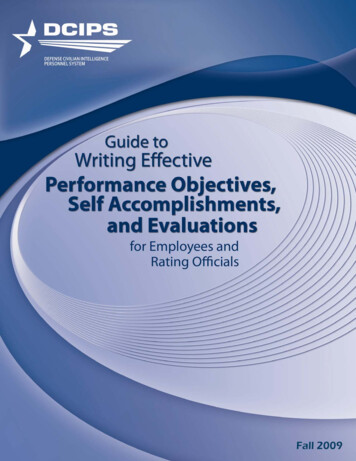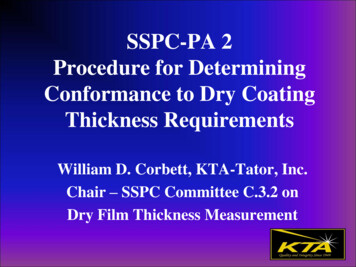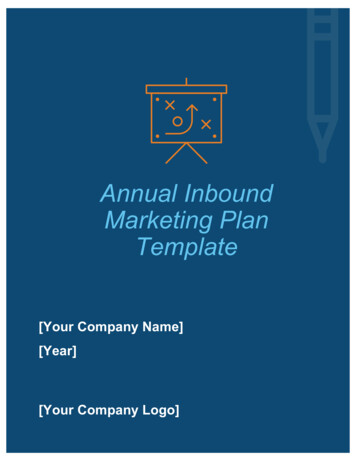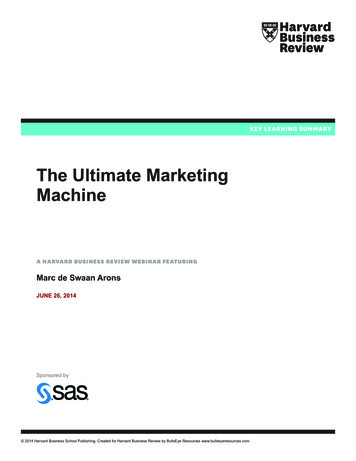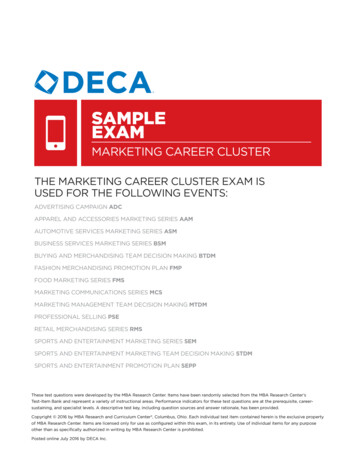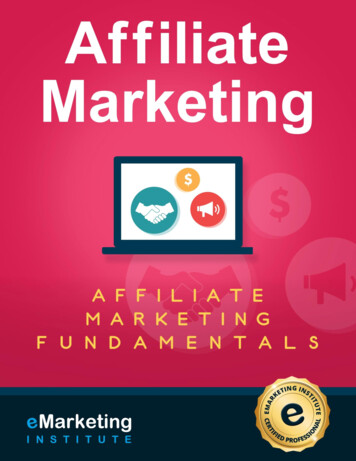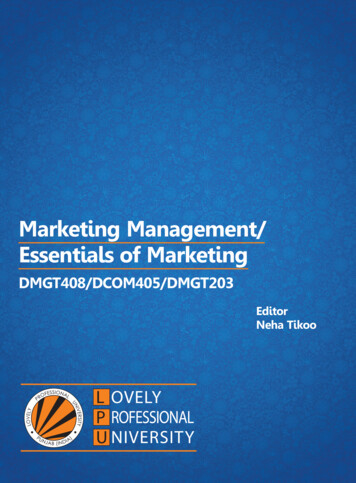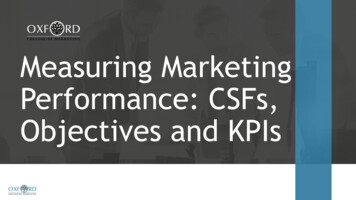
Transcription
Measuring MarketingPerformance: CSFs,Objectives and KPIs
Joe ShamiMBA MSc DipM PGCertHE FHEAStudied MSc in Information Systems,CIM DipM and later with an MBA.AboutMeAs the general manager for specialisedmanagement consultancy, workingclosely on the Royal Bank of ScotlandClient SME ownersOwn consultancy providing help andadvising a variety of business18 Years experience of teaching at bothUG and PGwww.oxfordcollegeofmarketing.com
From Mission to ActionsMission & Values - Why we exist and what we want to beCore Values - What we believe inObjectives - What we’re going to achieveStrategy - Our game planTactics – How we’re going to do itBalanced Scorecard - Implementation & ControlLEADS TOStrategic OutcomesSatisfied Stakeholders3Delighted CustomersEffective ProcessesMotivated, competent staff
Mission statement Establish what the company will and won't do Why do we do what we do ? who do we serve ? What distinguishes us
Components of a Mission Strategic intent – a vision of where you want to beMarket Definition – customer targetsCompetitive position – differential advantageDistinctive competences – core skillsCompany values – guiding principlesBoundaries – what it’s interested in doing and what it isn’t (scope)5
Considerations When Developing a MissionInternalBroadFocusExternalGeneral role; What sort oforganisation do we wantto be?Domain; Where can we operateeffectively Where do we want to operate?Values What do we see asimportant? How should our peoplebehave? What do we want to beknown for?Critical Success Factors What are we good at? What are we bad at? How are we perceived? What can we do strengthen orleverage our position?ScopeNarrow6Source; Wilson & Gilligan (2005) adapted from Piercy (1997)
Critical Success Factors "the limited number of areas in which satisfactory results will ensuresuccessful competitive performance for the individual, department ororganization. Critical success factors are the few key areas where 'things must goright' for the business to flourish and for the manager's goals to beattained." (Bullen & Rockart, 1981, p. 7).Bullen, C. V. & Rockart, J. F. (1981). A primer on critical success factors. Cambridge, MA: Center for Information Systems Research, MIT
What are CSF? The key areas of activity where performance will result in the success or failure of an organisation, service orunit Areas that need constant and careful attention from managers and continual measurement of performance A set of distinct and specific issues that taken together are both necessary and sufficient to achieve themission CSF are those factors that are either particularly valued by customers or which provide a significantadvantage in terms of cost. CSF are likely to be an important source of competitive advantage if an organisation has them (or adisadvantage if an organisation lacks them). Different industries and markets will have different critical success factors in low cost airlines the CSFs will be punctuality and value for money whereas in full-service airlines it is all about quality of service). CSF are often used to denote a mission statement, the vision of an organization, or simply for a businessstrategy. CSFs represent something that has to be in place for an objective/project to succeed Achieving CSFs drives your strategy forward. but typically only have binary values—yes and no.
Rockart distinguishes between 5 sources of CSF1. The industry, e.g., demand characteristics, technology employed, productcharacteristics etc. These can also affect all competitors within an industry, buttheir influence will vary according to the characteristics and sensitivity ofindividual industry segments.2. Competitive strategy and industry position of the business in question, which isdetermined by the history and competitive positioning in the industry.3. Environmental factors are the macroeconomic influences that affect allcompetitors within an industry, and over which the competitors have little orno influence, e.g., demographics, economic and government legislative policiesetc.4. Temporal factors, which are areas within a business causing a time-limiteddistress to the implementation of a chosen strategy, e.g., lack of managerialexpertise or skilled workers.5. Managerial position, i.e., the various functional managerial positions in abusiness have each their generic set of associated critical success factors.
Guidelines for CSF Aim to produce a maximum of 8 statements each statement must identify a new one specific factor There must be clear concise and easy to understand so that meaningsare not open to different interpretations Statements can cover both strategic and tactical issues They are often expressed in the form of “we must have” or “we need”(Caralli,2004; Oakland 2004)
2 main recognised methods of creating CSFquick method group brainstorming Can be done in a relatively short time
2 main recognised methods of creating CSFIn depth method Interviews and document analysis six stage process More time consuming needs research skillsother methods individual or group reflections in questionnaire surveys to identify service priorities
Benefits of CSFEstablishing critical SuccessFactors will make your key areas of activityexplicityou can then use your CSF: to inform your strategies and plans to focus your resources and activities to aid communication with stakeholders to establish performance measures for Quality management
Objectives They should be more precise than missionand goals should be quantifiable measures of theorganisation goals against which actualperformance can be assessed
Make objectives fast not smart
OKRs Vs. KPIs: Breaking Down The Difference OKR is the acronym for objective and key results (an objective is tied to key results) OKR is a strategic framework, whereas KPIs are measurements that exist within a framework. OKR is a simplistic, black-and-white approach that uses specific metrics to track the achievement of a goal. An organization will have 3 to 5 high-level objectives and 3 to 5 key results per objective. Key results are numerically graded to obtain a clear performance evaluation for the objective. OKRs are: Always quantifiable and Timelined Able to be objectively scored on a 0-1 or 0-100 scale Ambitious (if you easily achieve your objective, it wasn’t aggressive enough)Objective: Become the market leader in our industry. Key Result #1: Record 100 million in revenue by 2021. Key Result #2: Increase staff by 45 percent by 2021. Key Result #3: Increase market cap sufficiently to enter FTSE250 by is/
Mission statement to KPI Formulate a mission statement Create key performance indicators for a balanced scorecard Mission statement defines what actions are important to theorganisation KPI are the measures, rewards, the actions
Link between CSF and KPI
Defining Key Performance Indicators Specific, measurable goalsDirectly tied to theory of the businessReflect goals within perspectivesIncentivise desired behaviourLead to desired results
Key Performance Indicators KPIs, on the other hand, are measures used to quantify management objectives KPIs are derived from CSFs. KPIs indicate a defined performance level required to achieve a factor or set offactors critical to the success of an objective. Metric used to evaluate factors that important to an organisation success andgrowth Metric that helps organisations determine the effectiveness of their currentbusiness initiatives Help leaders to make more informed decisions and guide their company success1. Identify key measures2. Organised them3. design an evaluation system
Is “KPI” a Leading or a Lagging Indicator? As an indicator, it makes sense only in a certain context. Depending on the context it might be leading or lagging indicator. For example, NPS score (the quantified answer to the question “Howlikely is it that you would recommend our product to a colleague?”) Might be a lagging indicator for the “Improve customer service” Might be a leading indicator for “Increase g.htm#csf
What is the Difference Between a Leadingand a Lagging Indicator? It makes sense talking about the indicator type only in a certaincontext (business goal): The indicators related to the success factors of the goal arecalled leading indicators; The indicators related to the valuable outcomes of the goal arecalled lagging
What is an Easy Way to Find Leading andLagging Indicators? A starting point is a cause-and-effect analysis of the business context. Need to understand how things are interconnected. The result of such analysis is a list of: Stakeholders, Critical Success Factors and Desired business outcomes. Once we have CSF and expected outcomes, we can quantify andmeasure them
Identify root causes Core of the cause effect relationship Ask why 5 times Created by Toyoda the founder of Toyota
It is Not Just Semantics:Managing Outcomes Vs. Outputs Outputs, such as revenue and profit, enable us to fund outcomes; but withoutoutcomes, there is no need for outputs. Outcomes are the benefit your customers receive from your product starts with truly understanding your customers’ needs—their challenges, issues, constraints,priorities. Create a solution that your customers can sustain, and you enable life-changing outcomes,big and small. It is the outcomes that businesses want and need. Outcomes create meanings, relationships, and differences: the Why.Outputs are important products, services, profits, and revenues: the What.An output is what is created at the end of a processIn education we focus on test results (outputs) and ended up with high-scoringstudents who cannot apply what they learned in their company ntics-managing-outcomes
The Balanced ScorecardHow a company organises its key performance
The Balanced Scorecard FrameworkIs Readily Adapted to Non-Profit and Government OrganizationsThe Mission"If we succeed, howwill we look to ourfinancial donors?””To achieve our vision,how must we look toour customers?”“To satisfy our customers,financial donors and mission,what business processesmust we excel at?"“To achieve our vision, howmust our people learn,communicate, and worktogether?”The Mission, rather than the financial / shareholder objectives, drivesthe organization’s strategy
Profit marginhow many dollars ofprofit a companymakes for each 100in sales Monitor how thebusiness is working Leading measureIs the company meeting orexceeding customerexpectations leading outcomeAre customers staying withthe company andrecommending to others Focus on the companiesemployees as a resource Leading measureemployee training leading outcomeemployee productivity Productivity retention satisfaction
balanced-score-card-integrated.html
The Balanced Scorecardhttps://www.youtube.com/watch?v M IlOlywryw4k
Establishing critical success factors for information literacy - a methodology Sen & Corrall
Thank YouOxfordCollegeofMarketing@Oxcom egeofmarketing.com
An organization will have 3 to 5 high-level objectives and 3 to 5 key results per objective. Key results are numerically graded to obtain a clear performance evaluation for the objective. OKRs are: Always quantifiable and Timelin


